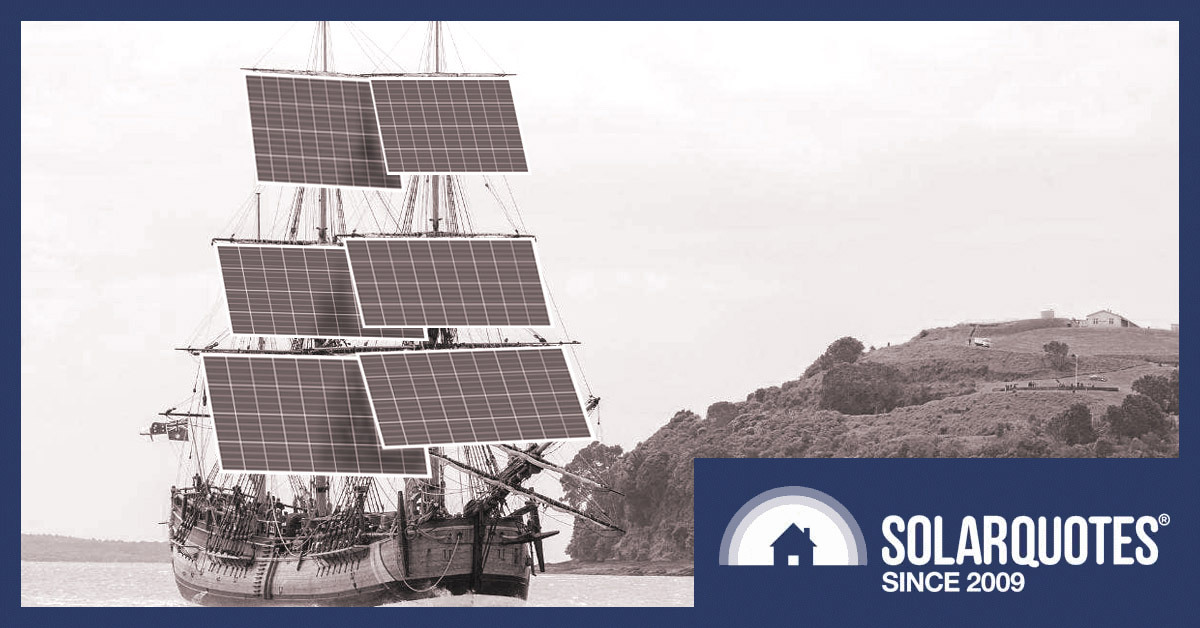
This article celebrates some of the events and people who pioneered the modern solar energy revolution in Australia over the past 80 years. Without these pioneers, Australia would not be the world leader in residential solar that it is today.
TLDR: See the whole Australian Solar Pioneers Timeline in this infographic.
Solar Hot Water And Research
1941 – The First Domestic Solar Water Heater
The first reported Australian domestic solar hot water heater was built by CSRI’s (now CSIRO) Roger Morse at Meringa Station near Cairns in Queensland. The system had a 20 square feet (1.9 m2) collector area and 40 gallons (180 litres) storage with no auxiliary heating. It was estimated to provide hot water for a household 300 days a year in the North Queensland climate.
1953 – Manufacturing Of Solar Hot Water Systems
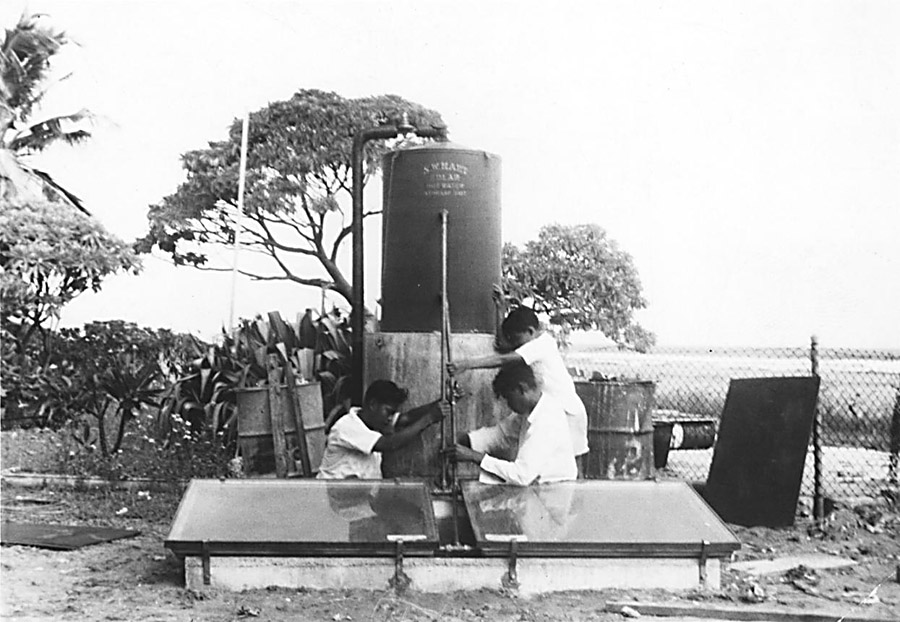
Solahart hot water system 1953, Cocos Islands. Image: Solahart
S. W. Hart and Co. Ltd began to manufacture Solahart hot water systems in Perth, Western Australia in 1953. The system operated on the thermosiphon principle, with a separately mounted copper tank. Over the years, Solahart has become a household name and is still in production; now part of the largest water heating manufacturing group in the world.
1955 – Solar Research Begins
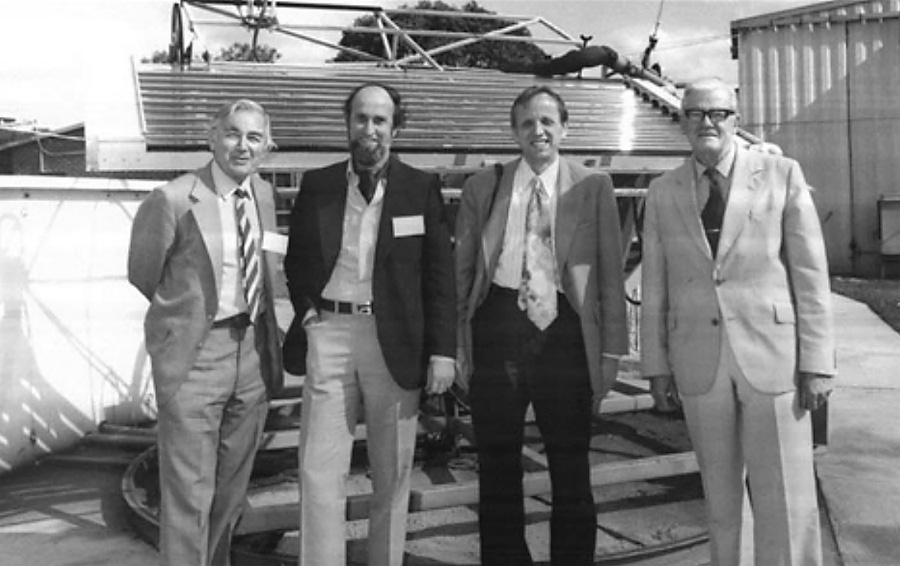
1950’s solar pioneers, Wall Read CSIRO, Bill Charters Univ of Melb, Jack Duffie, Univ of Wisconsin, Roger Morse CSIRO. Image: Researchgate
The CSIRO Engineering Section, spearheaded by Roger Morse and his team, began work on the design and manufacture of solar thermal systems. They would play a critical role in research and development for decades, setting up Australia to become a major manufacturer and exporter of solar hot water systems.
1962 – The Earliest Solar Organization
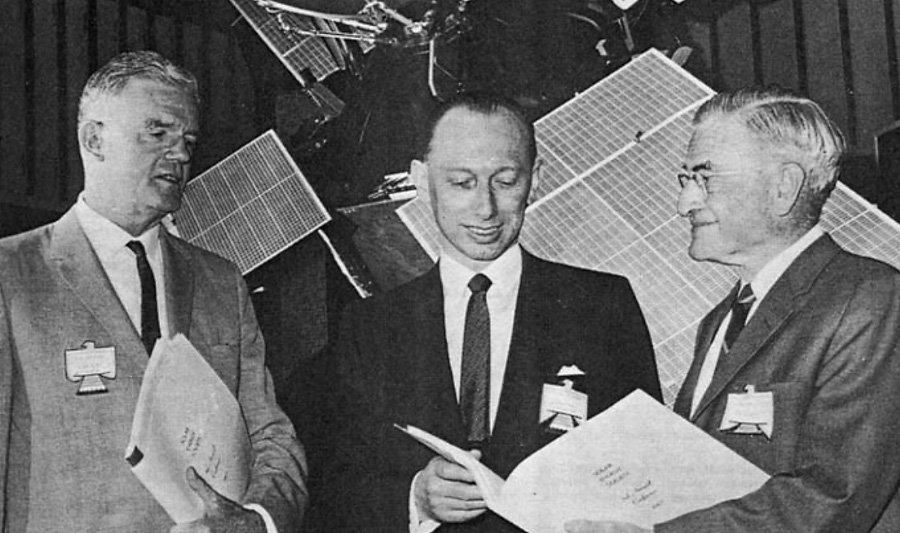
Roger Morse (left) and past ISES presidents. Image: Resarchgate
The inaugural meeting of the Australia New Zealand Branch of AFASE (Association For Applied Solar Energy) was held in August 1962. Roger Morse was elected chairman. This was the first organisation to promote and coordinate solar research and development in Australia.
The ANZ branch of AFASE would later be known as ANZSES, which was the ANZ branch of ISES (International Solar Energy Society).
1970 – The First Ever International Solar Energy Congress
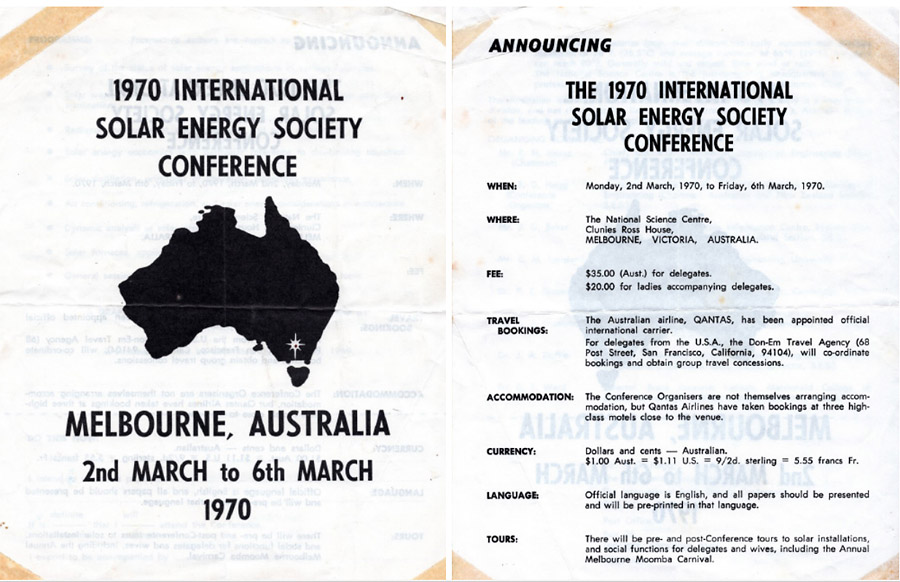
Solar Energy Society conference program. Image: ANZSES
The Australia New Zealand Solar Energy Society (ANZSES), formerly the ANZ branch of AFASE (above), hosted the world’s first international solar energy congress in Melbourne in June 1970. There were 152 participants including 72 from overseas, with 83 papers presented by scientists, engineers and academics.
The Birth Of The Solar Photovoltaic Industry
1974 – Stand-Alone Solar PV Systems
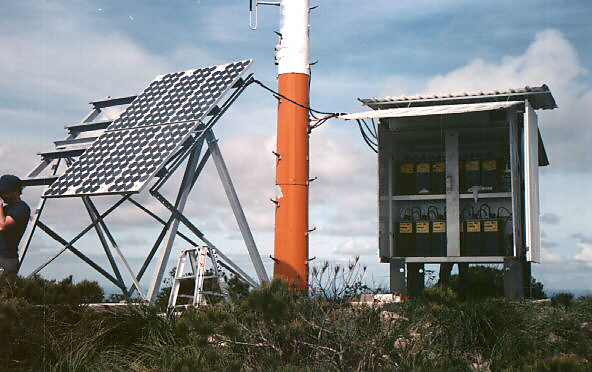
Early Telecom solar panel installation. Image: Coronium
Solar PV panels were initially used by Telecom (now Telstra) to power stand-alone systems for remote telecommunication. The solar panels were reportedly repurposed from satellites. Their first installation in 1974 was the power supply for a VHF subscriber radio terminal requiring about 4 watts of load.
As costs were reduced and low-power drain radio equipment was developed, major high-capacity microwave radio systems could be powered with solar cells. The Alice Springs link, installed in 1978, was the first of these.
At that time, the cost of solar modules was still too high for domestic use, however there were many commercial and industrial applications that made financial and operational sense.
1976 – The Alternative Technology Movement Begins
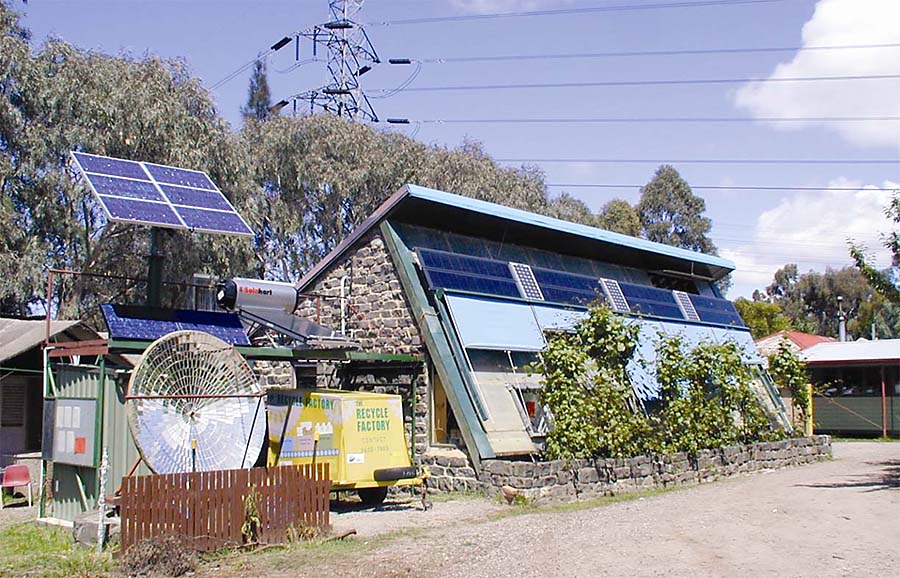
Alternative Energy Association solar workshop. Image: ReNew
The energy crisis in the 1970s raised awareness about conservation and the use of natural resources. A proactive group on green energy and technology began in 1976 after a meeting was called in a church room in Carlton, Victoria by Steven Ingrouille.
The Alternative Technology Corporation was born, later restructured and renamed ATA (Alternative Technology Association), and now re-branded as ReNew. Initially this was an intersection of alternative lifestyles and DIY amateur electronics, and now continues its work as a not-for-profit organization advocating for people and communities to live sustainably.
1978 – Passive Solar Building Design
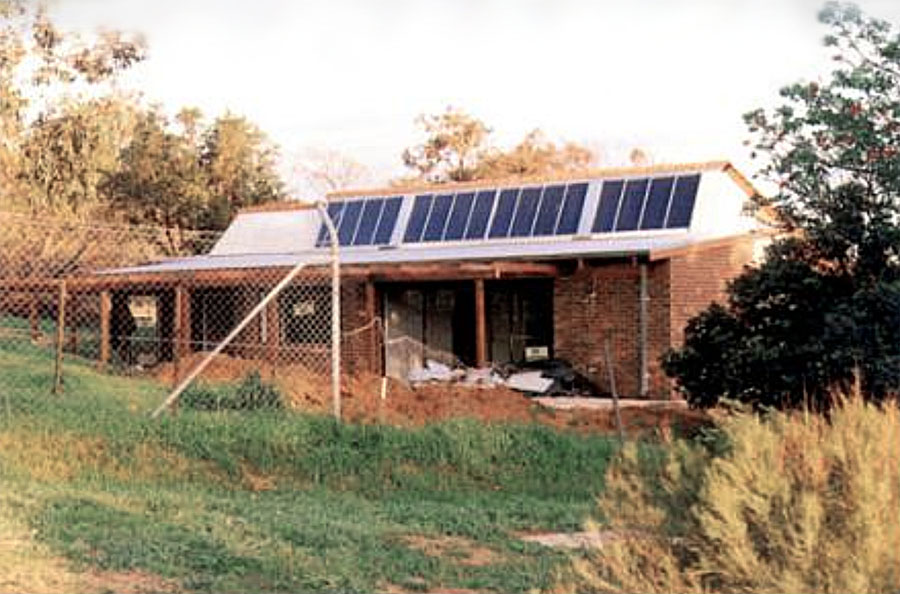
Solar Q1 passive solar building. Image: Garry Baverstock
The long-lost art of passive solar building design was rediscovered in the twentieth century, stimulated by the 1973 oil crisis. One of the most significant early examples is the Solar Q1 house built in Greenmount WA, which opened for display in 1978. Featuring a day-night heating/ cooling system using air collected in roof panels, this was the first example of wall insulation in brick cavity walls in Australia.
1980 – Australia’s PV Manufacturing Industry
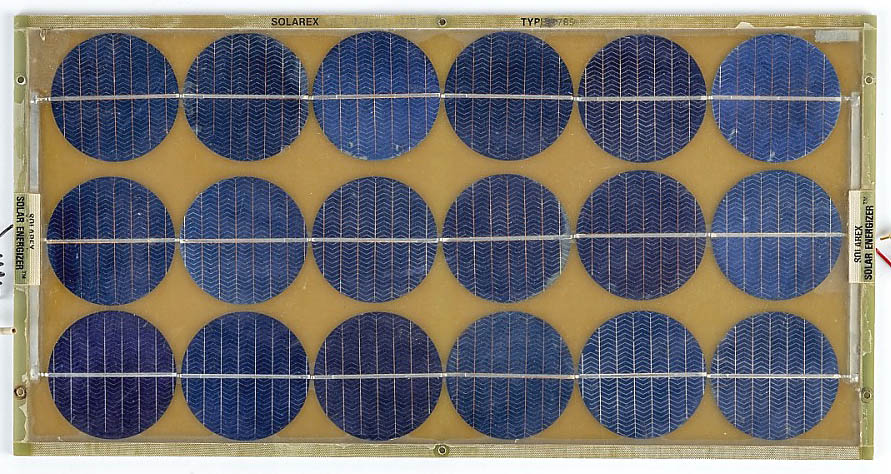
Solarex vintage solar panel. Image: Smithsonian Institute
Tideland Energy started producing solar modules in1980 at its manufacturing facilities in Brookvale, NSW. Two years later, it established Australia’s first commercial solar cell production line. Around the same time, Solarex began manufacturing solar panels in a small factory in Regents Park NSW.
Tideland was bought out by BP Solar Australia, which later merged with Solarex. Using technology from UNSW (University of NSW), they were a major supplier of solar panels to Telecom and also exported to USA and UK. They ceased production 30 years later, in 2010.
1981 – The First Solar (Thermal) Power Station
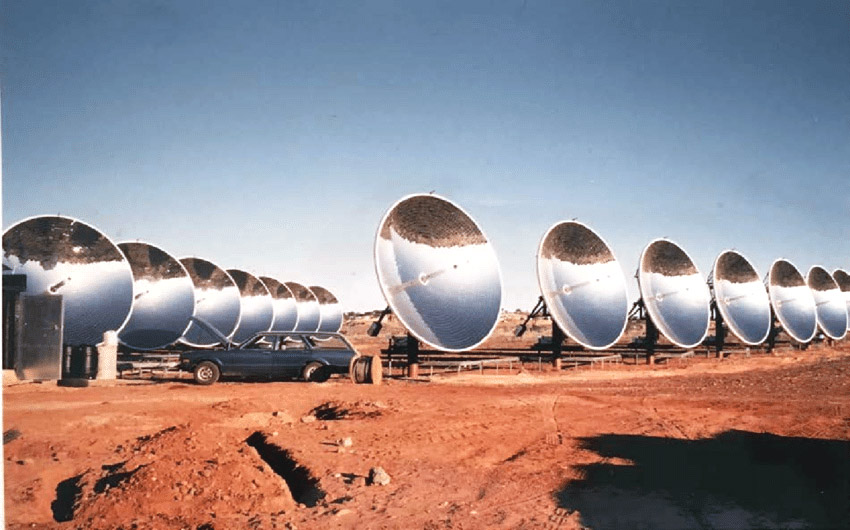
White Cliffs Power Station. Image: Researchgate
White Cliffs Power Station in NSW was Australia’s first, and arguably the world’s first, commercial solar power station. When it was constructed in 1981, it had no grid connection.
It consisted of fourteen 5-metre parabolic dishes, each covered by more than 2000 mirrors on a heliostatic mounting. The dishes focused the sun’s rays on a collector, where water was boiled. The resulting steam drove a 3-cylinder steam engine made by modifying a Lister diesel engine, powering a generator that delivered up to 25kW.
The station was grid connected in 1996 and converted to photovoltaics. It ceased operation in January 2005, and the site is now a museum.
Inventions And Breaking Records
1982 – First Transcontinental Solar Car Journey
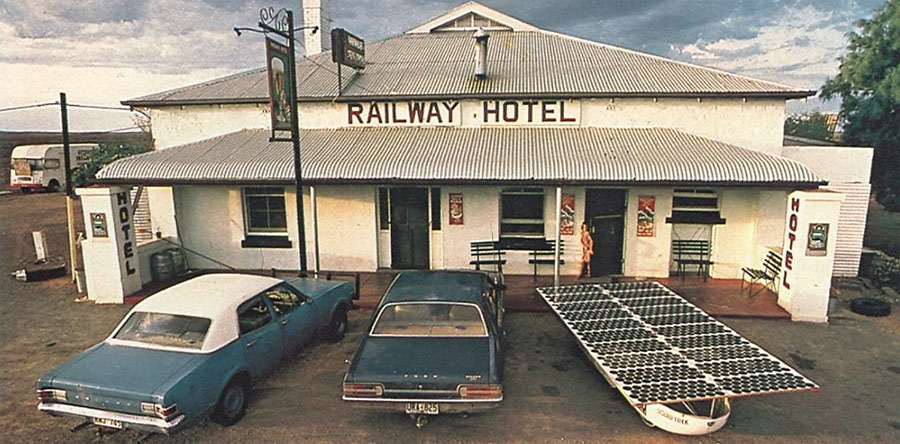
“The Quiet Achiever” parked outside the pub on it’s historic journey. Image: Tom Snooks
In 1982, Australian Hans Tholstrup and support driver Larry Perkins drove a solar-powered car 4000 km between Perth and Sydney in 20 days. This was ten days faster than the first ICE (Internal Combustion Engine) powered car to do so.
“The Quiet Achiever” was the first manned transcontinental journey using only solar power. The car’s 1 kW roof-mounted solar array consisted of two rows of ten 36-cell solar panels joined together with a total roof area of around 8.5 m2.
Tholstrup was the founder of the “World Solar Challenge” in Australia, considered the world championship of solar car racing. The inaugural event took place in 1987 and now runs 3000 km from Darwin to Adelaide every two years.
1983 – Invention of the Passivated Emitter and Rear Cell (PERC)
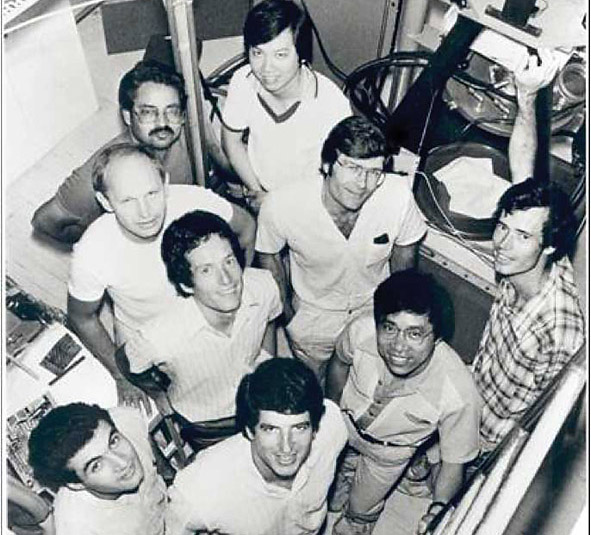
Martin Green and the UNSW team. Image: UNSW
Australian Professor Martin Green invented PERC technology in 1983 and over the next two decades perfected it with his team at UNSW (University of NSW). PERC technology is now used in more than 90 per cent of the world’s solar panels manufactured today.
In the same year, the UNSW team demonstrated the first 18% efficient silicon cell. The records kept on falling. 1989 – the first PV system with an energy conversion efficiency of 20%. 2014 – the first conversion of sunlight into electricity with an efficiency of 40% under normal conditions.
Professor Green is widely regarded as the world’s foremost photovoltaic researcher and the most distinguished academic in crystalline silicon solar cell research working today.
1985 – Manufacturing Off-Grid Solar Inverters
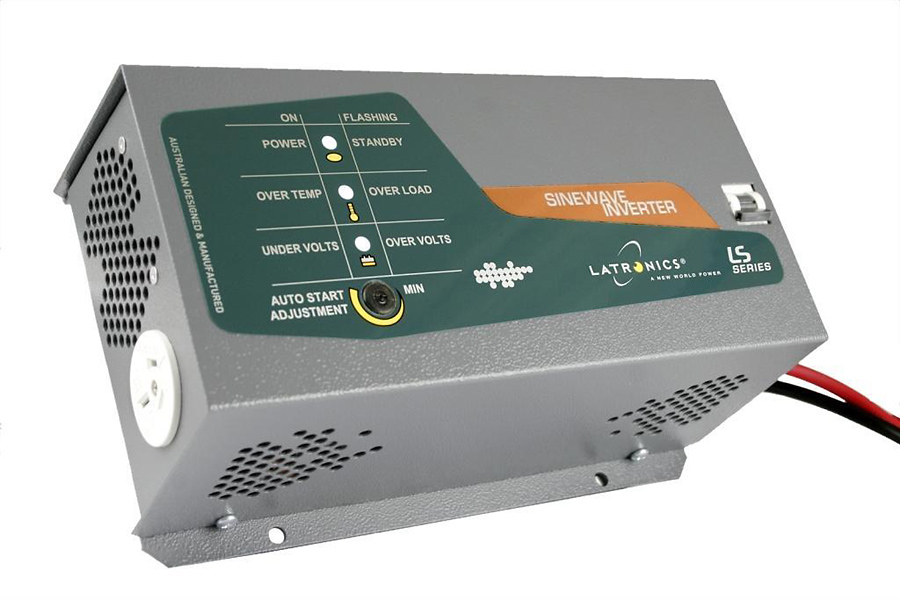
Latronics LS Series off-grid inverter. Image: Latronics
Pioneering Australian company Latronics started designing and manufacturing Off-Grid Inverters for solar energy systems in 1985. Their inverters have been used in domestic and industrial installations in more than 30 countries around the world.
A recent post on their website states that they will be ceasing production in 2025. They will release into the public domain all the design details and intellectual property of their entire range of LS off-grid inverters.
1985 – Invention Of The MPPT (Maximum Power Point Tracker)
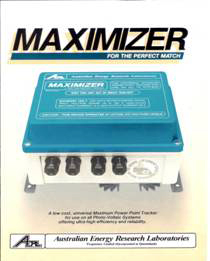
AERL Maximizer. Image: AERL
Stuart Watkinson from Australian company AERL invented the world’s first MPPT in 1985. This technology is now used in virtually all grid-connect solar inverters and MPPT solar charge controllers.
He devised an electronic unit that would efficiently extract the maximum electrical power from a small PV array and deliver it to a DC electric motor. The provisional patent was for an invention he named the Power Optimizer.
Stuart’s commercial product came to be known as the AERL Maximizer and was the world’s first MPPT Solar Charge Controller.
Grid Connected Solar PV
1993 – Australia’s First Grid Connected Solar/ Wind PV System
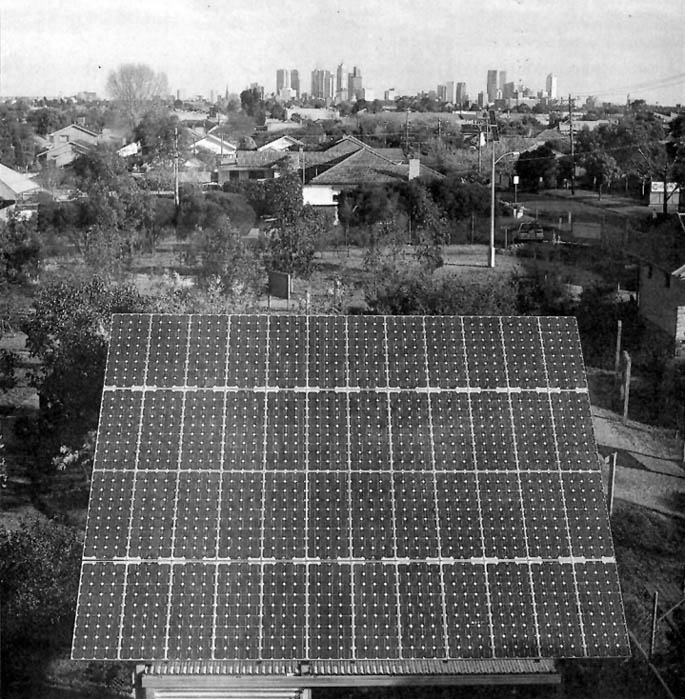
“Project Aurora” grid-connected solar/ wind system. Image: ReNew
This extract from a 1993 “Soft Technology” publication indicates not only is this the first instance of a grid-connected solar/ wind system in Australia, but also the first community solar farm/ garden.
“Project Aurora is a grid-connected wind/solar system located just 5 km from the Melbourne GPO. It was established by the local council power utility, the Brunswick Electricity Supply. Power from the 3.6 kilowatt BP SOLAR photovoltaic array and the 10 Kilowatt Bergey/ Westwind wind Turbine is fed into the local grid. A Butler Solar/ Siemens Sunshine, 3 phase, grid-interactive inverter is used to make the grid connection.”
“The system is expandable and Brunswick Electricity Supply is inviting interested people to buy a solar panel, or part of a solar panel, for inclusion in the grid-connected system. They will then pay the owners for the electricity contributed by the their solar panels.”
1994 – First Residential Grid-Connected Solar PV System
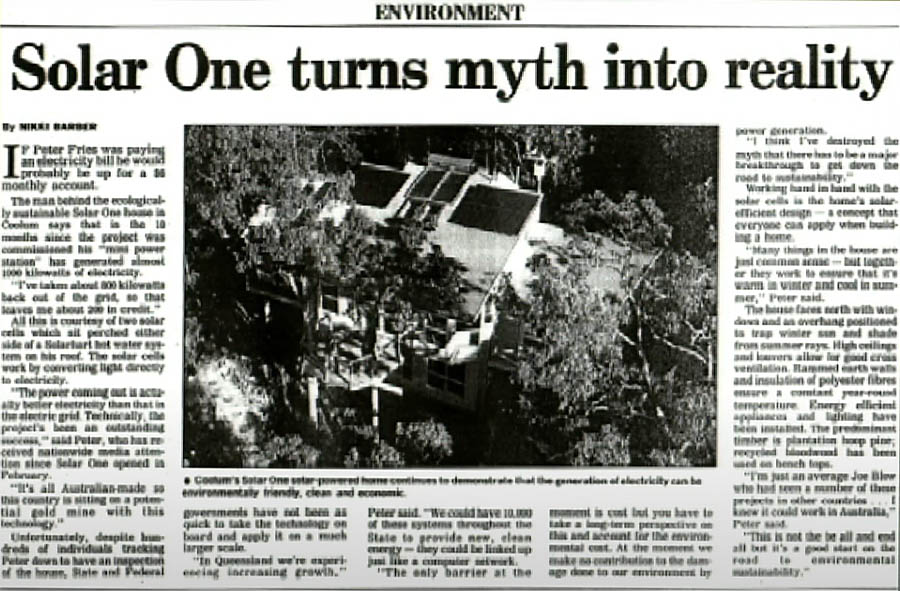
“Solar One” residential grid-connected PV system. Image: Peter Fries
The first documented residential PV solar system connected to an Australian power grid was in 1994 at a home owned by Peter Fries in Mt Coolum, Queensland. Dubbed “Solar One”, the 1.3 kW array consisted of 16 Solarex 83 W panels and an inverter designed by Aussie Dale Butler and manufactured by Siemens.
The energy-efficient 180m2 building used about 7 kWh/day. Two years of data from a flawless operation of the system formed the basis of SEQEB’s (now Energex) “Energy Buy Back Policy”. The exported electricity earned the project the first-ever cheque to a private homeowner for solar electricity fed into a grid: $7.
1994 – The First Licensed Solar PV Generating Facility In NSW
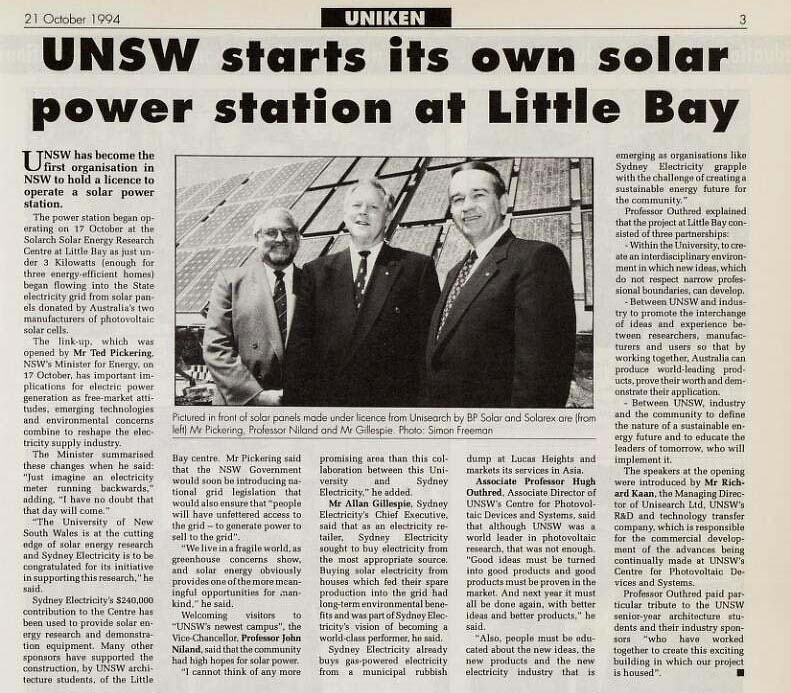
UNSW Little Bay PV power generator article. Image: National Library of Australia
In October 1994, the first licensed PV power generation facility in NSW was connected to the grid. The system consisted of a 3kW solar PV array, plus lead-acid batteries, on a new energy-efficient building at the UNSW Little Bay campus.
There were teething problems due to the wild fluctuations of electro-mechanical grid controls compared to more accurate electronic inverter settings. There were also issues getting permission to connect to the Energy Australia grid.
1998 – The Genesis Of Australian Standards For Grid-Connect Solar
What started as a solar architecture facility at UNSW grew into a very effective facility for the testing and demonstration of PV, and became the first grid-connected inverter testing and approval centre in Australia.
It was here in 1998 that Ted Spooner and others drafted “Grid Connect Guidelines for PV”. This later evolved into Australian Standard “AS4777: Grid Connection Of Energy Systems Via Inverters”, first published in 2002. This standard helped Australia safely and efficiently install over 3 million rooftop solar systems over the next 20 years. Australia now has more solar per capita than any other nation on Earth.
Thank you, solar pioneers.
The New Millennium
At the risk of never finishing this article, I’ve decided to arbitrarily end this chapter at the close of the twentieth century. The new millennium has and will continue to bring innovators and more pioneers in solar energy as technology continues to evolve. My apologies to the many other contributors of Australia’s rich history of solar, who I may have inadvertently missed. Hit me up in the comments with additions and any corrections.

 RSS - Posts
RSS - Posts



Thanks Kim, fascinating history. I saw Saul Griffith on TV last week say that Australian rooftop solar is currently the cheapest energy available anywhere in the world. Have you seen that quantified anywhere? I can believe it, just curious if anybody has done a comparison.
Cheers
A friend in Penrose, NSW has just de-commissioned her solar setup after 40+ years. The panels were still working, even though liberally coated with algae.
She is till off-grid, but with a modern system now.
I have the tower, 10kw turbine and control gear from the Aurora project in my personal collection, along with a few very early hand assembled solar modules.
Its interesting reading about the original projects when I was involved, even in a very small way.
Hi Chris. There isn’t too much info published about the Aurora Project. As I was researching for this article I came across several other grid connect systems claiming to be the first in Australia, but then somehow stumbled across this article in a 1993 edition of Soft Technology. Here’s a link to the whole publication… https://renewportal.org.au/wp-content/uploads/Renew_45.pdf
If you have any more info let me know.
Loved your article, Kim. It reminded me of so many important advances I’ve observed over the years. I knew the ATA were wonderful but didn’t realise how important they were. It was so good to hear the Latronics name again – I just knew there was another Oz inverter manufacturer. I’ve only been able to find Selectronics in recent years. I presume Latronics was first? Sad to see they are closing down.
Thanks again for putting my memories in order and into context, and for highlighting this important history!
Best regards
In 1941 my father was preparing to leave for New Guinea commanding an Engineering Company
In 1948 he was employed by CSIR to set up the Engineering Section (later Division) to service the organization.
He persuaded the organization to expand into the areas of solar, computing, comfort cooling and agriculture research, an example of which was building a machine to pick tea for the emerging tea growing industry in North Queensland
The solar water heater research began about 1952 and culminated in a paper authored by my father entitled “Solar water heating for domestic and farm use” which was presented by him to the inaugural conference of the “International Solar Engineering Society” (ISES) in Phoenix Arizona in 1955.
This of course predates the 1962 conference mentioned and the 1970 conference that incidentally my father organised.
This paper included manufacturing detail that was adopted by Solarhart and Beasley for the original manufactured units.
The design included a selective surface on the copper collector to reduce emissivity, double glazed low emissivity glass and tube sizes to produce a flow to give optimum heat transfer efficiency from the unit
I’m surprised that I can’t find mention of Professor Martin Green from University of NSW who developed the solar voltaic cell.
Hi Ian. Great to hear from you, and thanks for the update. You must be incredibly proud of your father. Roger Morse was indeed the first notable pioneer of solar energy in Australia, along with Professor Martin Green who I actually gave a mention regarding one of his many achievements – the invention of the Passivated Emitter and Rear Cell (PERC) in 1983.
Hi Ian – It is rather a long time since this Blog started but I would like to get in touch, through ISES, to see whether you would like to contribute some of your father’s historic material to the ISES online virtual Solar Museum – https://www.swc50.org/ises-online-solar-energy-museum. Roger Morse appears in the Solar Thermal section, slide 116. Also he appears in our Pioneer booklet and we would like to send you a copy. Please contact [email protected]
Thanks Kim for the article.
Australia has a prouder solar history than I thought. Really like the White cliffs parabolic solar thermal array. At the time I thought it was a winning technology as it was so much cheaper than PV.
Would love to read an article about solar technology invented and pioneered in Australia but manufactured overseas. 😉
Thanks Pedro, I’ll put that one on my list. I’m sure you can point me in the right direction 😉
Pretty much all of it? Heartbreaking. I know sometime who worked/ researched in Martin Greene’s lab and that’s what they found so heartbreaking – all the technology disappeared overseas when it came time for commercial manufacture – so Aistralia invested SO much in the R&D at an academic level, then didn’t follow through so lost out to China, Germany … you name it, when n it came to monetising all these inventions. Basically too many years of climate change denying liberal government killed off this industry in Australia..
Sophie, yes Australia has an unproud history of brain-drain. I’m not aware of the finer details in Martin Green’s case, however there’s a few innovators on this list that did start companies and manufacture in Australia. All we can do is celebrate them and encourage others to follow.
Hi Kim.
I was out spending quality time with my wife on Mother’s Day and another couple drove past where we were chatting. They stopped and the girls (they are members of the CWA) had a chat so I chatted to Dave. The conversation came to me living in Sydney years ago and his family also being in Sydney. I said Auburn and he said Seven Hills. I mentioned I had an old workmate who lived in Seven Hills. I gave him the address and he said his sister now lives in that house. I said back in the 70s I used to watch the Inventors on the ABC and a solar unit won the show and then the annual grand final. He looked sideways at me and I said my workmates father told us to follow him next door as the owner said it was ok to show us fitter machinist apprentices the workshop. Inside was the solar unit that won the Inventors show! Dave said no way? The man I was chatting to was the man who won the Inventors Show. He couldn’t believe that I had been in his workshop all those years ago. We will chat again sometime soon. I love solar and have two panels on our vintage caravan with 2 110v batteries. We also have 5kw on the roof of our home. Too much of our knowledge is being sold out overseas (or even given away)!